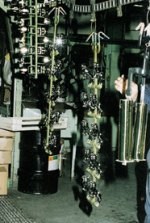Victoria Plating Had Emission Limits To Meet And Customers To Satisfy
Customers had quality requirements.
Customers had quality requirements. New York City and New York State had air compliance regulations. Victoria Plating, Bronx, NY, had provided its customers with quality finishes for 51 years. The environmental regulations demanded compliance, and owners Charles Antmann and Jeff Higdon refused to sacrifice finish quality.
Victoria specializes in plating high-volume, high-quality finishes using two return-type automated machines. The major substrate is zinc diecast, but the company also plates on steel and brass. It offers copper/nickel/chromium, brass, gold and black oxide finishes in addition to lacquer topcoats. Gold and black oxide finishes are done manually. Stampings, spinnings and castings are electroplated or polished to a high luster before applying a clear lacquer. The clear lacquer topcoat was the source of Victoria's emission troubles.
"Historically, we have offered three types of lacquer," noted Mr. Higdon, "waterborne dip lacquer, air-applied air-dry lacquer and a solvent-baked lacquer. The VOC limitations eliminated the air-dry lacquer capabilities, because of the solvents in it that were necessary for the coating to flash off."
According to Mr. Higdon, the regulations came into effect before a viable alternative had been developed. "Although enforcement was a bit lax at first, eventually we received a violation for air emissions," admitted Mr. Higdon. Fortunately, the EPA allowed Victoria to apply the monetary penalty toward the purchase of compliance equipment.
Victoria investigated several alternatives, including electrocoating, but found it cost prohibitive because it would be used intermittently. Thermal oxidizers and other VOC incineration methods were not practical also because of cost and because Victoria didn't know if it would even need these devices in the future if the solvent-borne lacquer went out of production. Victoria also tried lacquers containing chlorinated solvents but found they discolored aluminum parts.
Ultimately, Victoria installed a large oven and offered its customers a low-cure, clear, waterborne baked lacquer finish on the brass, bronze, copper and silver. The coating was developed and supplied by Agate Lacquer. "This was an expensive decision," noted Mr. Higdon. "The oven was costly, and with a baked lacquer there is more time involved.
"But because of that investment," Mr. Higdon said, "we were able to keep our customer base." Victoria's customers include notable manufacturers such as Mack Truck, Melard Shower and Stanley Tool.
After this investment and changeover to baked lacquer finishes only, Agate approached Victoria with a compliant air-dry lacquer. This enabled Victoria to again offer three types of lacquer finishes. "If there is a difference between an air-dry and a baked lacquer finish, it isn't obvious and has not affected production," remarked Mr. Higdon. "Also, it allows us to do more. You can't put a baked lacquer on plastics because of the oven temperature; now, we can lacquer plastics. You can't put a baked lacquer on certain substrates or finishes because of discoloration; now, we can coat these types of metals and finishes." But this didn't alleviate its compliance obligations.
Even though Mr. Higdon would rather spend more time in the finishing shop, the EPA keeps him tethered to his desk a significant portion of his time. "Charles Antmann and I made a decision back in the 80's that we were not going to manifest any waste, if possible. That was ok then, but now it is difficult because it is expensive, labor intensive and there is a lot of equipment maintenance. And as laws change, you have to spend more money and time," he added.
"I believe in the industry," avowed Mr. Higdon, "that is why I became involved with NAMF (National Association of Metal Finishers). Our relationship with EPA is ever evolving. Some days it is great, and other days it is tenuous. But you have to stay on top of things and know what is going on."
Victoria Plating has been able to keep up with all of the EPA and New York regulations. The low-VOC air-dry lacquer has helped the company comply with its air emission regulations. Customers still have their quality requirements. The environmental agencies have their emissions standards. And, Victoria Plating is still providing its customer with quality finishing.
Related Content
How to Choose Between Sulfate and Chloride-Based Trivalent Chromium
There are several factors to consider when choosing between sulfate and chloride-based baths for trivalent chromium plating. Mark Schario of Columbia Chemical discusses the differences and what platers should keep in mind when evaluating options.
Read MoreInnovation in Plating on Plastic
Plating on advanced plastics solution offers improved adhesion, temperature resistance and cost savings.
Read MoreLiquid Chrome Vs. Chromic Acid Flake
Contemplating how to continue offering chromic acid services in an increasingly stringent regulatory world? Liquid chrome products may be the solution you’re looking for.
Read MoreHow to Maximize Nickel Plating Performance
The advantages of boric acid-free nickel plating include allowing manufacturers who utilize nickel plating to keep up the ever-changing regulatory policies and support sustainability efforts.
Read MoreRead Next
Education Bringing Cleaning to Machining
Debuting new speakers and cleaning technology content during this half-day workshop co-located with IMTS 2024.
Read MoreA ‘Clean’ Agenda Offers Unique Presentations in Chicago
The 2024 Parts Cleaning Conference, co-located with the International Manufacturing Technology Show, includes presentations by several speakers who are new to the conference and topics that have not been covered in past editions of this event.
Read MoreEpisode 45: An Interview with Chandler Mancuso, MacDermid Envio Solutions
Chandler Mancuso, technical director with MacDermid Envio discusses updating your wastewater treatment system and implementing materials recycling solutions to increase efficiencies, control costs and reduce environmental impact.
Read More













.jpg;maxWidth=300;quality=90)










